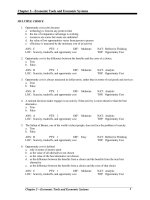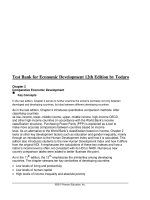Economic growth and economic development 12
Bạn đang xem bản rút gọn của tài liệu. Xem và tải ngay bản đầy đủ của tài liệu tại đây (44.92 KB, 1 trang )
Introduction to Modern Economic Growth
In contrast, the current book does not cover any of the short-run topics in macroeconomics, but provides a thorough and rigorous introduction
to what I view to be the core of macroeconomics. Therefore, the second
purpose of the book is to provide a first graduate-level course in modern
macroeconomics.
The topic selection is designed to strike a balance between the two purposes
of the book. Chapters 1, 3 and 4 introduce many of the salient features of the
process of economic growth and the sources of cross-country differences in economic
performance. Even though these chapters cannot do justice to the large literature
on economic growth empirics, they provide a sufficient background for students to
appreciate the set of issues that are central to the study of economic growth and
also a platform for a further study of this large literature.
Chapters 5-7 provide the conceptual and mathematical foundations of modern
macroeconomic analysis. Chapter 5 provides the microfoundations for much of the
rest of the book (and for much of modern macroeconomics), while Chapters 6 and
7 provide a quick but relatively rigorous introduction to dynamic optimization.
Most books on macroeconomics or economic growth use either continuous time or
discrete time exclusively. I believe that a serious study of both economic growth and
modern macroeconomics requires the student (and the researcher) to be able to go
between discrete and continuous time and choose whichever one is more convenient
or appropriate for the set of questions at hand. Therefore, I have deviated from this
standard practice and included both continuous time and discrete time material
throughout the book.
Chapters 2, 8, 9 and 10 introduce the basic workhorse models of modern macroeconomics and traditional economic growth, while Chapter 11 presents the first generation models of sustained (endogenous) economic growth. Chapters 12-15 cover
models of technological progress, which are an essential part of any modern economic
growth course.
Chapter 16 generalizes the tools introduced in Chapter 6 to stochastic environments. Using these tools, Chapter 17 presents the canonical stochastic growth
model, which is the foundation of much of modern macroeconomics (though it is
often left out of economic growth courses). This chapter also includes a discussion of the canonical Real Business Cycle model. Chapter 18 covers another major
workhorse model of modern macroeconomics, the neoclassical growth model with
incomplete markets. As well as the famous Bewley-Aiyagari model, this chapter discusses a number of other approaches to modeling the interaction between incomplete
markets and economic growth.
Chapters 19-23 cover a range of topics that are sometimes left out of economic
growth textbooks. These include models of technology adoption, technology diffusion, appropriate technology, interaction between international trade and technology, structural change, poverty traps, inequality, and population growth. These
xii









